

By
Don and Linda Freedman
Search
TheTravelzine
TheTravelzine Group
Access Your Mail
Don's
Gallery
Packing
Hints
Planning
Tips
Cities
Links
Links
LINKS TO OUR TRAVELOGUES
Argentina, Buenos Aires - Jan-Mar 2010
Argentina, Buenos Aires - Jan-Mar 2009
Argentina, Buenos Aires - Jan-Mar 2008
Austria - Fall 2005
Belgium, Brussels - Fall 2000
Canada - Summer 2002
Canada - Summer 2001
Canada - Summer 2000
Czech Republic - Spring 2000
France - Fall 2002
France, Paris - Fall 2000
France, Paris - Spring 1999
France, Lyon - Spring 1999
Germany, Berlin - Fall 2009
Germany - Fall 2002
Germany - Spring 2000
Germany - Fall 1999
Greece - Fall 2012
Greece - Fall 1999
Greece - Fall 1997
Hungary - Spring 2000
Israel - Fall 1999
Italy - Winter 2007
Italy - Winter 2006
Italy - Winter 2005
Italy - Winter 2004
Italy - Winter 2003
Italy - Winter 2001
Italy - Fall 1998
Italy - Fall 1996
Netherlands - Spring 2000
Portugal, Azores - 2019
Portugal, Azores - 2018
Portugal, Sao Miguel & Lisbon - 2017
Portugal, Azores - 2017
Portugal, Azores - 2016
Portugal, Azores - 2015
Portugal, Azores - 2014
Portugal, Azores - 2013
Portugal, Azores - 2012
Portugal, Azores - 2011
Portugal, Lisbon - 2011
Portugal - Fall 2006
Portugal - Fall 2004
Portugal - Fall 2003
Portugal - Fall 2001
Portugal - Spring 1999
Portugal - Spring 1997
Slovakia - Spring 2000
Slovenia - Spring 1999
Slovenia - Fall 1996
Spain, Barcelona - Winter 2006
Switzerland - Fall 2002
Switzerland - Spring 2000
Switzerland - Spring 1999
Switzerland - Fall 1998
Switzerland - Fall 1997
Switzerland - Spring 1996
U.S. Florida, Key West - Fall 2006
U.S. Florida - Spring 2001
U.S. Maine - Summer 2002
U.S. Massachusetts - Summer 2003
U.S. Massachusetts - Summer 2002
U.S. Massachusetts - Summer 2001
U.S. New York State - Fall 2005
U.S. New York State - Summer 2004
U.S. New York State - Summer 2003
U.S. New York State - Summer 2001
U.S. Washington,DC - Spring 2000
Forty Days
Celebrating Forty Years!
Fall 2002
Bremen | Hamburg | Berlin
Potsdam | Dresden,
Bautzen and Gorlitz
Nürnberg | Karlsruhe | Zürich | Strasbourg | Bern
Annecy | Avignon | Marseille | Aix-en-Provence | Paris
Berlin (2)
This was to be a very full day in the east, starting at the Jewish Museum. We boarded bus #129 across from our hotel on Ku'Damm, which followed a picturesque route along the Landwehrkanal to the Lindenstrasse stop.
Much has been written about the Jewish Museum of Berlin, its radical design, its goals and its architect, Daniel Libeskind. We came away from our visit convinced of the genius of the architect in communicating a complex philosophical issue utilizing documented facts and history in a brilliantly created spatial environment. His goal was to help Germans, and in particular Berliners, to accept responsibility for their turbulent pass and to confront old attitudes.
The history of anti-semitism is carefully traced and documented as far back as 1096. Is it not time for it to stop? Jewish life, traditions and culture and their contributions to German art, culture and business are depicted to enlighten those who are unfamiliar with the life and history of the German Jewish people.
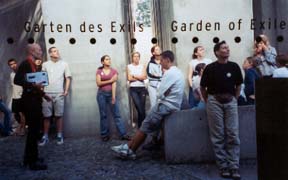 Libeskind's message is nowhere more
poignantly delivered than in his treatment of the
Holocaust. The museum is designed around a series of
physical voids and open spaces, which represent the empty
silence left by that horrific tragedy. The Garden of
Exile wants you to think about the disorientation that
exile brings. Forty-nine columns are filled with earth in
which willow oak trees grow. Forty-eight contain earth
from Berlin and stand for the 1948 formation of the State
of Israel. The forty-ninth central column is filled with
earth from Jerusalem and stands for Berlin itself.
Libeskind's message is nowhere more
poignantly delivered than in his treatment of the
Holocaust. The museum is designed around a series of
physical voids and open spaces, which represent the empty
silence left by that horrific tragedy. The Garden of
Exile wants you to think about the disorientation that
exile brings. Forty-nine columns are filled with earth in
which willow oak trees grow. Forty-eight contain earth
from Berlin and stand for the 1948 formation of the State
of Israel. The forty-ninth central column is filled with
earth from Jerusalem and stands for Berlin itself.
The Memory Void is for thinking and
contemplating. It is the largest of the vertical closed
spaces symbolically recognizing that the elimination of
European Jews has caused an absence or void in German,
European Society.
[Back
to Top]
The Israeli sculptor Menashe Kadishman created a sculpture that is the most powerful reminder of the Holocaust imaginable. Rusted iron disks representing faces with cut-outs for the features are meant to depict death and the horror and suffering that was endured. These disks are strewn and piled in a long, narrow corridor with high bare walls and there are areas at different levels outside the chamber from which you are able to view this incredibly moving memorial as you visit other floors of the museum.
Beside the deliberately disorienting architecture of tilts, slants and angles, the factual content is presented in a comprehensive and coherent manner, making the message abundantly clear. The collections of art, artifacts, religious material, etc. is considerable and brilliantly organized to depict Jewish life and history.
Personal stories of very special people and their deeds and case studies with letters and photographs illustrate the hate and persecution of the Jews in Germany prior to and during the war.
It was significant for us to see a group of new military recruits (18 months of military service is compulsory at this writing) and many groups of school children in attendance. This is good - it is in the hands of the new generation to reverse the tide of history.
The Jewish Museum is located in the
old eastern sector in the Kreuzberg district. North is
the Mitte District, the heart of the old east, and
Berlin's current hotspot. Friedrichstrasse is the
dividing line between the old west and east and is
challenging Ku'Damm to be the luxury avenue of the
unified city. Quite a change from being a death street
for wall-jumpers, it is now an intriguing mix of Bauhaus,
art deco and modern architecture housing the finest
upscale shops and department stores. 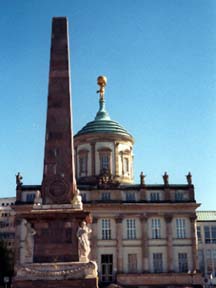
Just east of Friedrichstrasse
between Checkpoint Charley and Unter den Linden is
Gendarmenmarkt, often called Berlin's finest square. It
is extremely striking, framed by the imposing facades of
the Schauspielhaus and the French and German cathedrals.
The stunning boulevard Unter den Linden runs east from
the Brandenburg Gate into Mitte and is once again
becoming a fashion center with fine shops and department
stores lining the way. Unter den Linden which, by the
way, celebrated its 350th birthday in 1997, is also
surrounded by gigantic historic buildings, such as
Humboldt University and the German State Library. 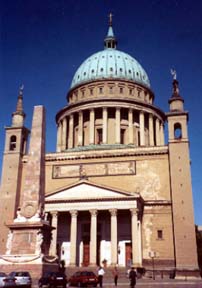
Just off the boulevard is August
Bebel Platz, with the Silent Library, commemorating the
Nazi book burning. The monument is simply a square of
glass at your feet through which you see a square room
lined wall-to-wall with empty book shelves - a very
powerful statement indeed.
[Back
to Top]
In trying to rebuild its image, Berlin decided to focus its efforts around the cultural infrastructure created by unification and to make Berlin "The City of Museums". The center of this undertaking is Museum Island on the River Spree, smack in the middle of Mitte. Here stand five monumental buildings, constructed between 1830 and 1930, designed by Germany's finest architects of the time. These exquisite buildings were turned into a site of desolation by the war and then neglected by the Communist Regime. At least a billion dollars will be spent over ten years or more to restore these structures to their original glory. The content of each museum has been decided as well as a plan to link the museums so that thousands of years of art can be seen for the price of a single ticket.
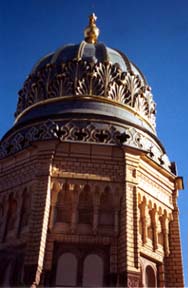 The old Jewish Quarter was in the triangle
formed by Torstrasse, Rosenthalerstrasse and
Ornienburgerstrasse, where the New Synagogue and Jewish
Center preserve the past. Nearby streets, such as
Auguststrasse, Sophienstrasse and Joachimstrasse are now
home to galleries, trendy boutiques, artisan shops,
cafes, bars and restaurants. In this lively area is the
well-known artist's colony called Tacheles on
Oranienburgerstrasse, a bombed-out, graffiti-covered mess.
Inside are scattered studios and questionable bars
surrounding a littered courtyard with a beer garden.
Berlin's famous counter-culture has roots here. The old,
neglected buildings are slowly being renovated and
rebuilt creating delightful living and working space. At
the southeast corner of the triangle is the hot, hot
Hackescher Markt, a collection of beautifully-renovated
industrial buildings, innovatively-designed with eight
linked courtyards. The art nouveau architecture is
brilliant. The buildings house residences, offices and a
theatre and the courtyards cater to the good times and
leading-edge fashion. Eat, drink, be merry and look cool!
The old Jewish Quarter was in the triangle
formed by Torstrasse, Rosenthalerstrasse and
Ornienburgerstrasse, where the New Synagogue and Jewish
Center preserve the past. Nearby streets, such as
Auguststrasse, Sophienstrasse and Joachimstrasse are now
home to galleries, trendy boutiques, artisan shops,
cafes, bars and restaurants. In this lively area is the
well-known artist's colony called Tacheles on
Oranienburgerstrasse, a bombed-out, graffiti-covered mess.
Inside are scattered studios and questionable bars
surrounding a littered courtyard with a beer garden.
Berlin's famous counter-culture has roots here. The old,
neglected buildings are slowly being renovated and
rebuilt creating delightful living and working space. At
the southeast corner of the triangle is the hot, hot
Hackescher Markt, a collection of beautifully-renovated
industrial buildings, innovatively-designed with eight
linked courtyards. The art nouveau architecture is
brilliant. The buildings house residences, offices and a
theatre and the courtyards cater to the good times and
leading-edge fashion. Eat, drink, be merry and look cool!
The synagogue is quite stunning. There's a small museum that is easily accessible but the main sanctuary is open only on Friday evenings and on Saturdays for the Sabbath. We climbed up a zillion stairs to the dome for excellent city views. From this lofty spot we could see the Jewish Center complex behind the synagogue, including the modern gymnasium building with six cone-shape skylights.
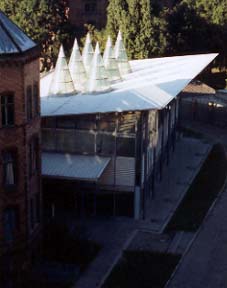 Next we moved over to the neighboring
triangle formed by Hackescher Markt, Rose-Luxemburg Platz
and Rosenthaler Platz for even more outrageous fashion
and places for refreshment and fun.
Next we moved over to the neighboring
triangle formed by Hackescher Markt, Rose-Luxemburg Platz
and Rosenthaler Platz for even more outrageous fashion
and places for refreshment and fun.
Mitte is ground zero in Berlin for
the young fashion and art scene. As the area becomes more
mainstream and touristy, the designers, artists,
photographers and their groupies are moving north, south
and east to keep their culture alive and the cost-of-living
down.
[Back
to Top]
We seriously hate to shop but we do appreciate and enjoy an exceptional retail operation, of which there are few. In Paris we will go to BHV (Bazaar Hotel de Ville), across from Hotel de Ville (City Hall), a brilliantly merchandised department store. Today we were in Berlin and had to visit the world famous KeDeWe. It will never be famous for its facade, but inside it is truly special. The elegant design is complemented by the thoughtful use of space and traffic flow. The enormous assortment of merchandise is brilliantly presented and displayed to enable shopping with ease and comfort. Only the finest brands and labels are to be found. This huge emporium caters to the wealthy.
The sixth floor is devoted to feeding the affluent clientele. We were impressed at the seafood counter where the chef was grilling whole fish and filets for the waiting patrons. There were at least a dozen fish and a couple of dozen filets cooking away, filling the area with a delicious aroma. Anything and everything you might want to eat was on display throughout the expansive area. We made it a quick walk-through to minimize the torture. (No eating between meals and snacks!) KeDeWe deserves its illustrious reputation.
We were now in the mood for some traditional German cuisine so we headed over to a place that looked like a winner when we passed-by a day or two earlier, Gasthaus Krombach at Meinekesstrasse 4, which runs south from Ku'Damm a few blocks from our hotel. We sat on high stools at a table in the bar area. There are several dining areas all done in dark woods with framed pictures of movie stars gracing the walls. Our delightful waitress suggested we share grilled bratwurst (two large beauties) with sauerkraut and mashed potatoes and Konigsberger Klopse (two huge homemade meatballs) with caper sauce and boiled potato. Our traditional local feast, complemented by a large dark beer for each of us, was perfectly marvelous - great food, wonderful value, highly recommended!
We didn't walk in the expansive and
gorgeous Tiergarten in the center of the city. We didn't
explore the scenic waterways nor did we get to a museum
other than the Jewish Museum. Berlin is, in and of
itself, a living museum. We have just begun to peel away
some of the layers of this fascinating city and it will
take us many visits to approach the core.
[Back
to Top]
Potsdam
We did not want to give up a minute of our time in Berlin, but we felt that we should zip over to Potsdam for at least a brief visit. Potsdam is twenty minutes away on the S-Bahn 7, which we picked up at the Zoologischer station. This trip, by the way, is included in the 18 EUR 72 hour Berlin Welcome Card good for prepaid transportation and discounts on various attractions, a great bargain.
Potsdam is actually an island in a thickly-treed chain of lakes of the Havel River. The baroque old town is a dandy and then there are the enchanting parks and the mind-blowing palaces.
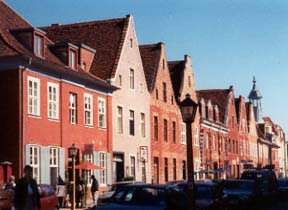 From the station, we crossed the Havel on
the Lange Brucke to first encounter the Alter Markt,
where the Stadtschloss Palace, which was destroyed during
the war, is being rebuilt to its original form. The Neuer
Markt has been reconstructed and houses many important
and impressive buildings. As we proceeded north on the
main street, Friedrich-Eberstrasse, the soft pastel-colored
buildings were a joy to behold. No shortage of food,
drink and neat things to buy. Branderburgerstrasse with
its old inner courtyards and contemporary arcades is a
wide pedestrian street catering to hungry shoppers.
Further north off of Friedrich-Ebertstrasse is the Dutch
Quarter, the largest preserved Dutch-style settlement
outside of the Netherlands.
From the station, we crossed the Havel on
the Lange Brucke to first encounter the Alter Markt,
where the Stadtschloss Palace, which was destroyed during
the war, is being rebuilt to its original form. The Neuer
Markt has been reconstructed and houses many important
and impressive buildings. As we proceeded north on the
main street, Friedrich-Eberstrasse, the soft pastel-colored
buildings were a joy to behold. No shortage of food,
drink and neat things to buy. Branderburgerstrasse with
its old inner courtyards and contemporary arcades is a
wide pedestrian street catering to hungry shoppers.
Further north off of Friedrich-Ebertstrasse is the Dutch
Quarter, the largest preserved Dutch-style settlement
outside of the Netherlands.
The quarter is two blocks square of beautifully-preserved buildings and cobblestone, tree-lined streets. Many interesting restaurants and cafes caught our attention, but we did not want to take time to indulge in a sit-down meal, settling instead for a herring sandwich and ice cream on the move while on Brandenburgerstrasse.
We sort-of hit a wall in terms of energy and time and decided the best course of action would be to take buses to see at least two of the parks. At the Rathaus stop we boarded bus 692 for a peek at the Neuer Garten. This is Potsdam's second largest park designed as an English landscape garden at the end of the 18th century. There are three major structures, the Marble Palace, Cecilienhof Palace, and the Belvedere on the Pffingstberg. All were built for royalty of that period. The palaces were under renovation so the views of each were limited.
We did not get to Babelsburg Park
with its Babelberg Palace and Flatow Tower of the 19th
century, but after bus 692 we got on bus 695 to drive
through the emperor of all parks - Sanssouci. It is one
of the largest and most important parks in Europe, a
combination of fascinating garden design and illustrious
architecture made this an enchanting tour. It would take
several days to walk this phenomenal site to appreciate
each structure and the surrounding landscape. We caught
enough good views to literally jump out of our seats with
excitement. The Sanssouci Palace is just simply
captivating. At each turn in the road another beauty
emerged from the greenery: the Picture Gallery containing
baroque paintings, the stunning Chinese House, the
Historic Windmill, and the list goes on. We found Potsdam
a very special experience. Imagine how we will feel when
one day we get up close.
[Back
to Top]
Bremen | Hamburg | Berlin
Potsdam | Dresden,
Bautzen and Gorlitz
Nürnberg | Karlsruhe | Zürich | Strasbourg | Bern
Annecy | Avignon | Marseille | Aix-en-Provence | Paris
Search TheTravelzine | TheTravelzine Group | Don's Gallery
Packing Hints | Planning
Tips | Cities
Links
All pages on TheTravelzine.comİCopyright 1996-2020 Don & Linda Freedman